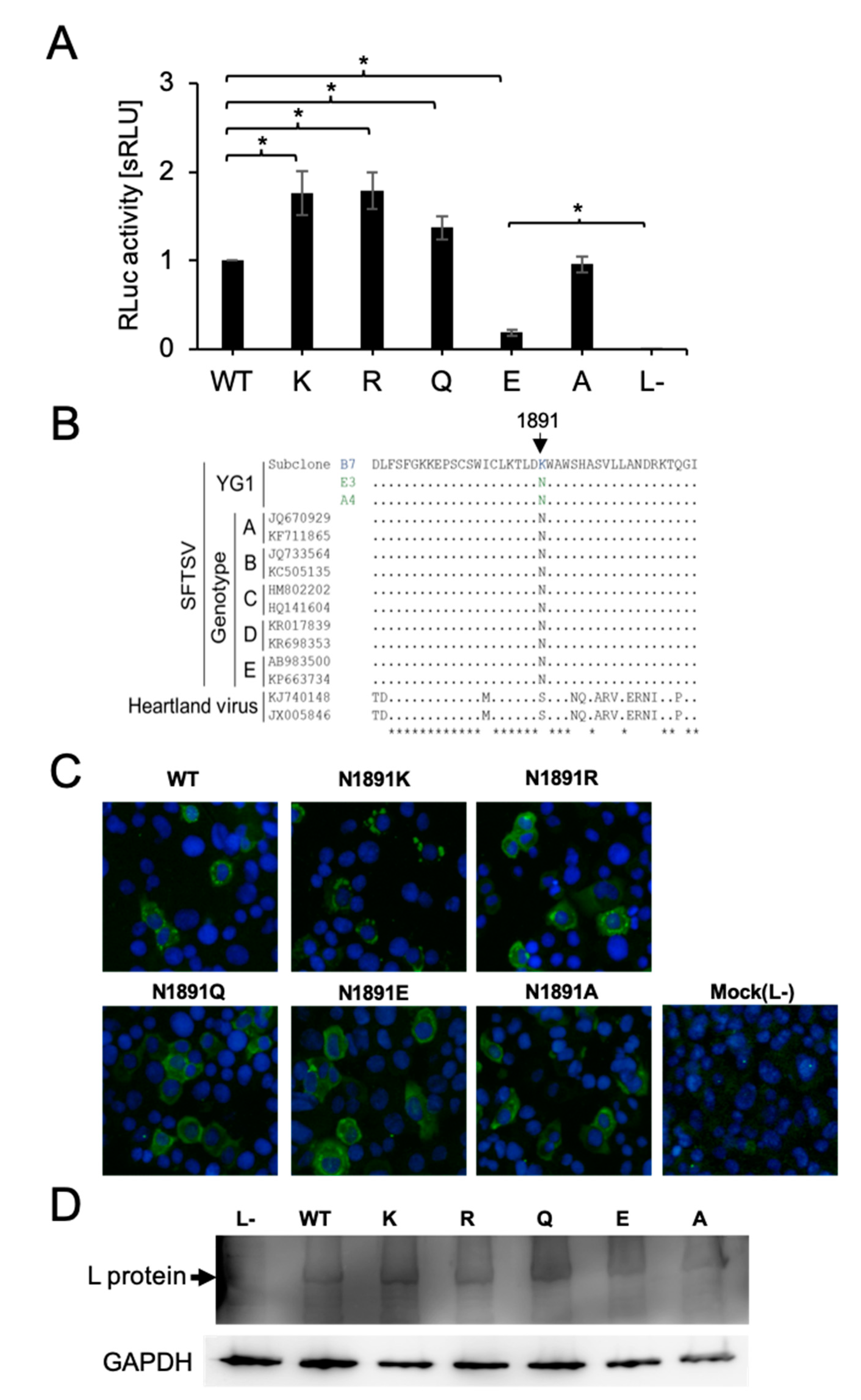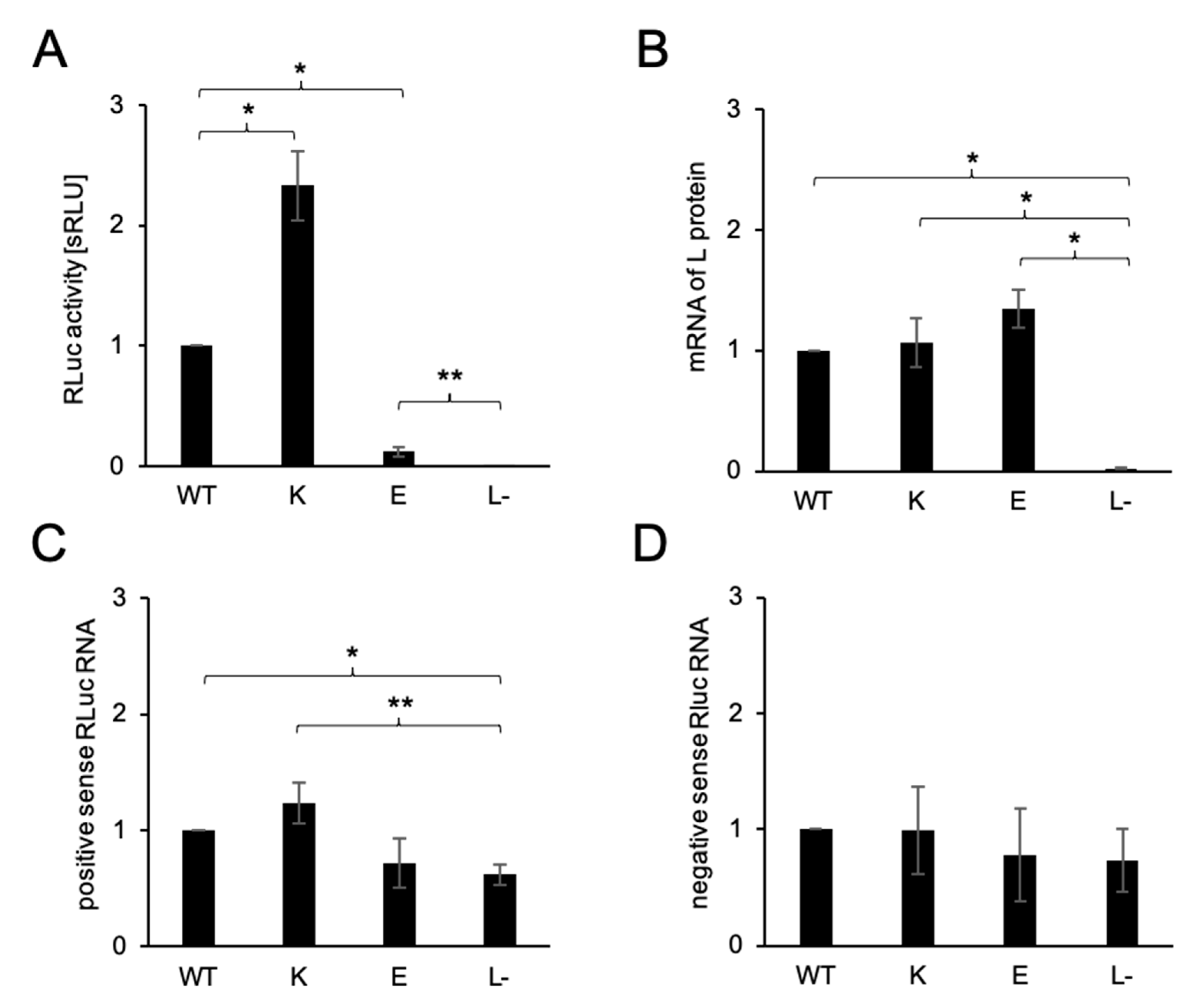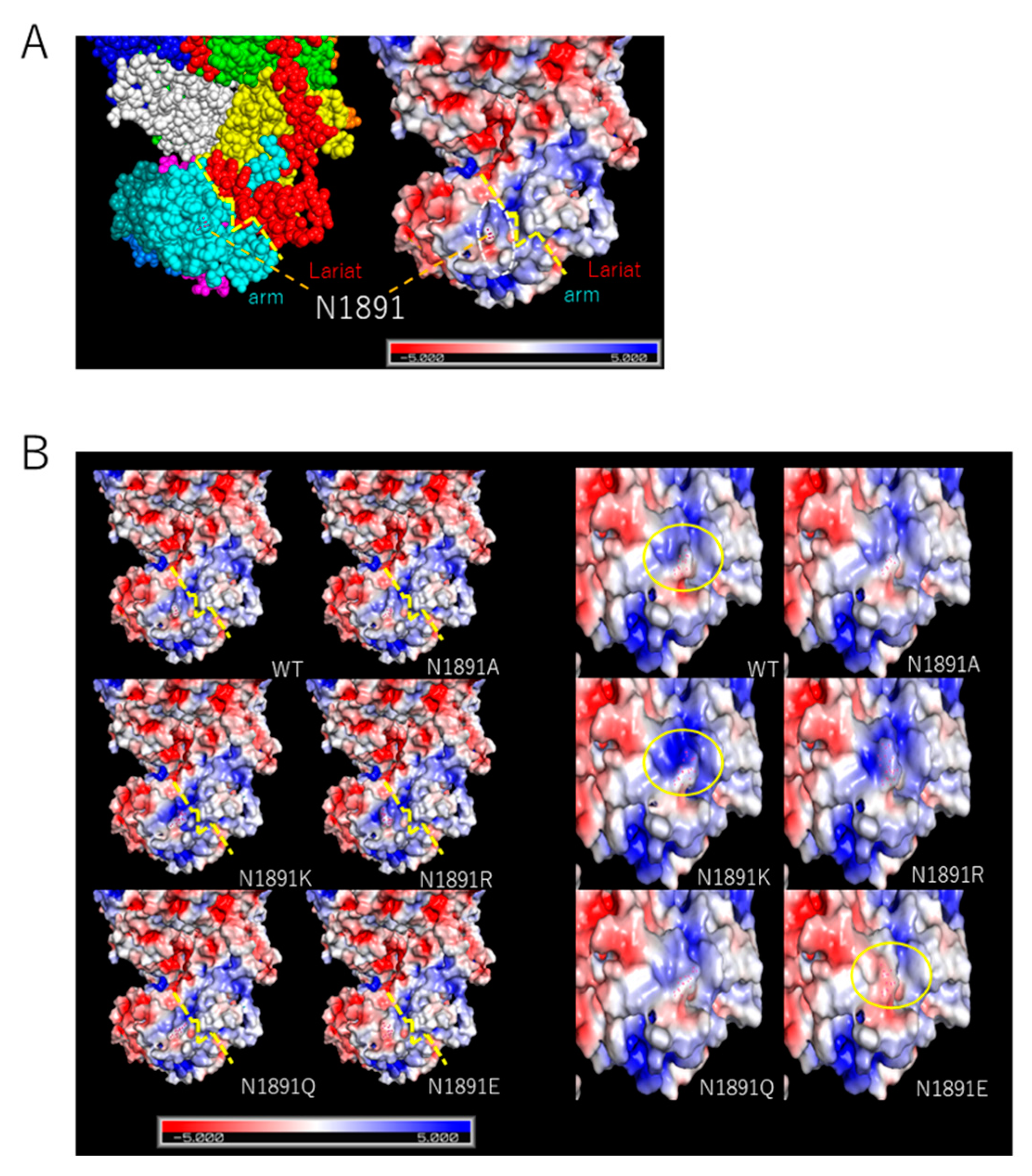The Polarity of an Amino Acid at Position 1891 of Severe Fever with Thrombocytopenia Syndrome Virus L Protein Is Critical for the Polymerase Activity
Abstract
1. Introduction
2. Materials and Methods
2.1. Cells
2.2. Construction and Expression of SFTSV L Protein Variant Plasmids
2.3. Indirect Immunofluorescence Assay
2.4. Western Blot Assay
2.5. Minigenome Assay
2.6. Quantitative PCR (qPCR) Assay
2.7. In Silico Structural Analysis
3. Results
3.1. Estimating the Location of Position 1891 on the Structural Model of the SFTSV L Protein
3.2. Minigenome Assay for SFTSV L Protein Variants
3.3. qPCR Assay under the Minigenome System Conditions
3.4. In Silico Surface Charge Analyses of the SFTSV L Protein Variants
4. Discussion
Author Contributions
Funding
Institutional Review Board Statement
Data Availability Statement
Acknowledgments
Conflicts of Interest
References
- Bao, C.J.; Guo, X.L.; Qi, X.; Hu, J.L.; Zhou, M.H.; Varma, J.K.; Cui, L.B.; Yang, H.T.; Jiao, Y.J.; Klena, J.D.; et al. A family cluster of infections by a newly recognized bunyavirus in eastern China, 2007: Further evidence of person-to-person transmission. Clin. Infect. Dis. 2011, 53, 1208–1214. [Google Scholar] [CrossRef] [PubMed]
- Takahashi, T.; Maeda, K.; Suzuki, T.; Ishido, A.; Shigeoka, T.; Tominaga, T.; Kamei, T.; Honda, M.; Ninomiya, D.; Sakai, T.; et al. The First Identification and Retrospective Study of Severe Fever With Thrombocytopenia Syndrome in Japan. J. Infect. Dis. 2014, 209, 816–827. [Google Scholar] [CrossRef] [PubMed]
- Shimojima, M.; Fukushi, S.; Tani, H.; Yoshikawa, T.; Morikawa, S.; Saijo, M. Severe fever with thrombocytopenia syndrome in Japan. Uirusu 2013, 63, 7–12. [Google Scholar] [CrossRef] [PubMed][Green Version]
- Kim, K.H.; Yi, J.; Kim, G.; Choi, S.J.; Jun, K.I.; Kim, N.H.; Choe, P.G.; Kim, N.J.; Lee, J.K.; Oh, M.D. Severe fever with thrombocytopenia syndrome, South Korea, 2012. Emerg. Infect. Dis. 2013, 19, 1892–1894. [Google Scholar] [CrossRef]
- Ding, F.; Zhang, W.; Wang, L.; Hu, W.; Soares Magalhaes, R.J.; Sun, H.; Zhou, H.; Sha, S.; Li, S.; Liu, Q.; et al. Epidemiologic Features of Severe Fever With Thrombocytopenia Syndrome in China, 2011–2012. Clin. Infect. Dis. 2013, 56, 1682–1683. [Google Scholar] [CrossRef]
- Tran, X.C.; Yun, Y.; Van An, L.; Kim, S.H.; Thao, N.T.P.; Man, P.K.C.; Yoo, J.R.; Heo, S.T.; Cho, N.H.; Lee, K.H. Endemic Severe Fever with Thrombocytopenia Syndrome, Vietnam. Emerg. Infect. Dis. 2019, 25, 1029–1031. [Google Scholar] [CrossRef]
- Zohaib, A.; Zhang, J.S.; Saqib, M.; Athar, M.A.; Hussain, M.H.; Chen, J.; Sial, A.U.; Tayyab, M.H.; Batool, M.; Khan, S.; et al. Serologic Evidence of Severe Fever with Thrombocytopenia Syndrome Virus and Related Viruses in Pakistan. Emerg. Infect. Dis. 2020, 26, 1513–1516. [Google Scholar] [CrossRef]
- Kobayashi, Y.; Kato, H.; Yamagishi, T.; Shimada, T.; Matsui, T.; Yoshikawa, T.; Kurosu, T.; Shimojima, M.; Morikawa, S.; Hasegawa, H.; et al. Severe Fever with Thrombocytopenia Syndrome, Japan, 2013–2017. Emerg. Infect. Dis. 2020, 26, 692–699. [Google Scholar] [CrossRef]
- Yu, X.J.; Liang, M.F.; Zhang, S.Y.; Liu, Y.; Li, J.D.; Sun, Y.L.; Zhang, L.; Zhang, Q.F.; Popov, V.L.; Li, C.; et al. Fever with thrombocytopenia associated with a novel bunyavirus in China. N. Engl. J. Med. 2011, 364, 1523–1532. [Google Scholar] [CrossRef]
- Peng, S.H.Y.; Yang, S.L.; Tang, S.E.; Wang, T.C.; Hsu, T.C.; Su, C.L.; Chen, M.Y.; Shimojima, M.; Yoshikawa, T.; Shu, P.Y. Human Case of Severe Fever with Thrombocytopenia Syndrome Virus Infection, Taiwan, 2019. Emerg. Infect. Dis. 2020, 26, 7. [Google Scholar] [CrossRef]
- Nishio, S.; Tsuda, Y.; Ito, R.; Shimizu, K.; Yoshimatsu, K.; Arikawa, J. Establishment of Subclones of the Severe Fever with Thrombocytopenia Syndrome Virus YG1 Strain Selected Using Low pH-Dependent Cell Fusion Activity. Jpn. J. Infect. Dis. 2017, 70, 388–393. [Google Scholar] [CrossRef] [PubMed]
- Tsuda, Y.; Igarashi, M.; Ito, R.; Nishio, S.; Shimizu, K.; Yoshimatsu, K.; Arikawa, J. The amino acid at position 624 in the glycoprotein of SFTSV (severe fever with thrombocytopenia virus) plays a critical role in low-pH-dependent cell fusion activity. Biomed. Res. 2017, 38, 89–97. [Google Scholar] [CrossRef] [PubMed]
- Tani, H.; Kawachi, K.; Kimura, M.; Taniguchi, S.; Shimojima, M.; Fukushi, S.; Igarashi, M.; Morikawa, S.; Saijo, M. Identification of the amino acid residue important for fusion of severe fever with thrombocytopenia syndrome virus glycoprotein. Virology 2019, 535, 102–110. [Google Scholar] [CrossRef] [PubMed]
- Gogrefe, N.; Reindl, S.; Günther, S.; Rosenthal, M. Structure of a functional cap-binding domain in Rift Valley fever virus L protein. PLoS Pathog. 2019, 15, e1007829. [Google Scholar] [CrossRef] [PubMed]
- Vogel, D.; Thorkelsson, S.R.; Quemin, E.R.J.; Meier, K.; Kouba, T.; Gogrefe, N.; Busch, C.; Reindl, S.; Gunther, S.; Cusack, S.; et al. Structural and functional characterization of the severe fever with thrombocytopenia syndrome virus L protein. Nucleic Acids Res. 2020, 48, 5749–5765. [Google Scholar] [CrossRef]
- Wang, P.; Liu, L.; Liu, A.; Yan, L.; He, Y.; Shen, S.; Hu, M.; Guo, Y.; Liu, H.; Liu, C.; et al. Structure of severe fever with thrombocytopenia syndrome virus L protein elucidates the mechanisms of viral transcription initiation. Nat. Microbiol. 2020, 5, 864–871. [Google Scholar] [CrossRef]
- Lundu, T.; Tsuda, Y.; Ito, R.; Shimizu, K.; Kobayashi, S.; Yoshii, K.; Yoshimatsu, K.; Arikawa, J.; Kariwa, H. Targeting of severe fever with thrombocytopenia syndrome virus structural proteins to the ERGIC (endoplasmic reticulum Golgi intermediate compartment) and Golgi complex. Biomed. Res. 2018, 39, 27–38. [Google Scholar] [CrossRef]
- Brennan, B.; Li, P.; Zhang, S.; Li, A.; Liang, M.; Li, D.; Elliott, R.M. Reverse genetics system for severe fever with thrombocytopenia syndrome virus. J. Virol. 2015, 89, 3026–3037. [Google Scholar] [CrossRef]
- Rezelj, V.V.; Mottram, T.J.; Hughes, J.; Elliott, R.M.; Kohl, A.; Brennan, B. M segment-based minigenomes and virus-Like particle assays as an approach to assess the potential of tick-borne phlebovirus genome reassortment. J. Virol. 2019, 93, e02068-18. [Google Scholar] [CrossRef]
- Elliott, R.; Schmaljohn, C. Bunyaviridae. In Fields Virology, 6th ed.; Knipe, D.M., Howley, P.M., Eds.; Lippincott Williams & Wilkins: Philadelphia, PA, USA, 2013; Volume 1, pp. 1244–1282. [Google Scholar]
- Reguera, J.; Weber, F.; Cusack, S. Bunyaviridae RNA polymerases (L-protein) have an N-terminal, influenza-like endonuclease domain, essential for viral cap-dependent transcription. PLoS Pathog. 2010, 6, e1001101. [Google Scholar] [CrossRef]
- Reguera, J.; Gerlach, P.; Rosenthal, M.; Gaudon, S.; Coscia, F.; Günther, S.; Cusack, S. Comparative Structural and Functional Analysis of Bunyavirus and Arenavirus Cap-Snatching Endonucleases. PLoS Pathog. 2016, 12, e1005636. [Google Scholar] [CrossRef] [PubMed]
- Holm, T.; Kopicki, J.D.; Busch, C.; Olschewski, S.; Rosenthal, M.; Uetrecht, C.; Günther, S.; Reindl, S. Biochemical and structural studies reveal differences and commonalities among cap-snatching endonucleases from segmented negative-strand RNA viruses. J. Biol. Chem. 2018, 293, 19686–19698. [Google Scholar] [CrossRef] [PubMed]
- Jones, R.; Lessoued, S.; Meier, K.; Devignot, S.; Barata-García, S.; Mate, M.; Bragagnolo, G.; Weber, F.; Rosenthal, M.; Reguera, J. Structure and function of the Toscana virus cap-snatching endonuclease. Nucleic Acids Res. 2019, 47, 10914–10930. [Google Scholar] [CrossRef] [PubMed]
- Morin, B.; Coutard, B.; Lelke, M.; Ferron, F.; Kerber, R.; Jamal, S.; Frangeul, A.; Baronti, C.; Charrel, R.; de Lamballerie, X.; et al. The N-terminal domain of the arenavirus L protein is an RNA endonuclease essential in mRNA transcription. Plos Pathog. 2010, 6, e1001038. [Google Scholar] [CrossRef]
- Ferron, F.; Weber, F.; de la Torre, J.C.; Reguera, J. Transcription and replication mechanisms of Bunyaviridae and Arenaviridae L proteins. Virus Res. 2017, 234, 118–134. [Google Scholar] [CrossRef]
- Olschewski, S.; Cusack, S.; Rosenthal, M. The Cap-Snatching Mechanism of Bunyaviruses. Trends Microbiol. 2020, 28, 293–303. [Google Scholar] [CrossRef]
- Jérôme, H.; Rudolf, M.; Lelke, M.; Pahlmann, M.; Busch, C.; Bockholt, S.; Wurr, S.; Günther, S.; Rosenthal, M.; Kerber, R. Rift Valley fever virus minigenome system for investigating the role of L protein residues in viral transcription and replication. J. Gen. Virol. 2019, 100, 1093–1098. [Google Scholar] [CrossRef]
- Yoshikawa, T.; Shimojima, M.; Fukushi, S.; Tani, H.; Fukuma, A.; Taniguchi, S.; Singh, H.; Suda, Y.; Shirabe, K.; Toda, S.; et al. Phylogenetic and Geographic Relationships of Severe Fever With Thrombocytopenia Syndrome Virus in China, South Korea, and Japan. J. Infect. Dis. 2015, 212, 889–898. [Google Scholar] [CrossRef]
- Subbarao, E.K.; London, W.; Murphy, B. A single amino acid in the PB2 gene of influenza A virus is a determinant of host range. J. Virol. 1993, 67, 1761–1764. [Google Scholar] [CrossRef]
- Hatta, M.; Gao, P.; Halfmann, P.; Kawaoka, Y. Molecular basis for high virulence of Hong Kong H5N1 influenza A viruses. Science 2001, 193, 1840–1842. [Google Scholar] [CrossRef]
- Mok, C.K.; Lee, H.H.; Lestra, M.; Nicholls, J.M.; Chan, M.C.; Sia, S.F.; Zhu, H.; Poon, L.L.; Guan, Y.; Peiris, J.S. Amino acid substitutions in polymerase basic protein 2 gene contribute to the pathogenicity of the novel A/H7N9 influenza virus in mammalian hosts. J. Virol. 2014, 88, 3568–3576. [Google Scholar] [CrossRef] [PubMed]
- Nilsson, B.E.; Te Velthuis, A.J.W.; Fodor, E. Role of the PB2 627 Domain in Influenza A Virus Polymerase Function. J. Virol. 2017, 91, e02467-16. [Google Scholar] [CrossRef] [PubMed]




| Primer Sequence | Primer Name |
|---|---|
| AAATGGGCCTGGTCACATGCC | SFTSV LN1891K_Fw |
| AGGTGGGCCTGGTCACATGCC | SFTSV LN1891R_Fw |
| GAATGGGCCTGGTCACATGCC | SFTSV LN1891E_Fw |
| GCGTGGGCCTGGTCACATGCC | SFTSV LN1891A_Fw |
| CAATGGGCCTGGTCACATGCC | SFTSV LN1891Q_Fw |
| GTCAAGAGTTTTCAAGCAGATCC | SFTSV LD1890_Rv |
| Primer Sequence | Primer Name |
|---|---|
| TGATCCAGAACAAAGGAAACG | RLuc 18Fw |
| GAAACTTCTTGGCACCTTCAAC | RLuc 820Rv |
| TGGGCAAATCAGGCAAATC | RLuc 242Fw |
| CCAAACAAGCACCCCAATC | RLuc 376Rv |
| AGCAGCGTCTCACCAAATCTC | SFTSV L3613Fw |
| GCAGGAGCTGAGCGCACTGT | SFTSV L3730Rv |
Publisher’s Note: MDPI stays neutral with regard to jurisdictional claims in published maps and institutional affiliations. |
© 2020 by the authors. Licensee MDPI, Basel, Switzerland. This article is an open access article distributed under the terms and conditions of the Creative Commons Attribution (CC BY) license (http://creativecommons.org/licenses/by/4.0/).
Share and Cite
Noda, K.; Tsuda, Y.; Kozawa, F.; Igarashi, M.; Shimizu, K.; Arikawa, J.; Yoshimatsu, K. The Polarity of an Amino Acid at Position 1891 of Severe Fever with Thrombocytopenia Syndrome Virus L Protein Is Critical for the Polymerase Activity. Viruses 2021, 13, 33. https://doi.org/10.3390/v13010033
Noda K, Tsuda Y, Kozawa F, Igarashi M, Shimizu K, Arikawa J, Yoshimatsu K. The Polarity of an Amino Acid at Position 1891 of Severe Fever with Thrombocytopenia Syndrome Virus L Protein Is Critical for the Polymerase Activity. Viruses. 2021; 13(1):33. https://doi.org/10.3390/v13010033
Chicago/Turabian StyleNoda, Kisho, Yoshimi Tsuda, Fumiya Kozawa, Manabu Igarashi, Kenta Shimizu, Jiro Arikawa, and Kumiko Yoshimatsu. 2021. "The Polarity of an Amino Acid at Position 1891 of Severe Fever with Thrombocytopenia Syndrome Virus L Protein Is Critical for the Polymerase Activity" Viruses 13, no. 1: 33. https://doi.org/10.3390/v13010033
APA StyleNoda, K., Tsuda, Y., Kozawa, F., Igarashi, M., Shimizu, K., Arikawa, J., & Yoshimatsu, K. (2021). The Polarity of an Amino Acid at Position 1891 of Severe Fever with Thrombocytopenia Syndrome Virus L Protein Is Critical for the Polymerase Activity. Viruses, 13(1), 33. https://doi.org/10.3390/v13010033






